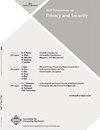SAM: Query-Efficient Adversarial Attacks Against Graph Neural Networks
IF 3
4区 计算机科学
Q2 COMPUTER SCIENCE, INFORMATION SYSTEMS
引用次数: 1
Abstract
Recent studies indicate that Graph Neural Networks (GNNs) are vulnerable to adversarial attacks. Particularly, adversarially perturbing the graph structure, e.g., flipping edges, can lead to salient degeneration of GNNs’ accuracy. In general, efficiency and stealthiness are two significant metrics to evaluate an attack method in practical use. However, most prevailing graph structure-based attack methods are query intensive, which impacts their practical use. Furthermore, while the stealthiness of perturbations has been discussed in previous studies, the majority of them focus on the attack scenario targeting a single node. To fill the research gap, we present a global attack method against GNNs, Saturation adversarial Attack with Meta-gradient, in this article. We first propose an enhanced meta-learning-based optimization method to obtain useful gradient information concerning graph structural perturbations. Then, leveraging the notion of saturation attack, we devise an effective algorithm to determine the perturbations based on the derived meta-gradients. Meanwhile, to ensure stealthiness, we introduce a similarity constraint to suppress the number of perturbed edges. Thorough experiments demonstrate that our method can effectively depreciate the accuracy of GNNs with a small number of queries. While achieving a higher misclassification rate, we also show that the perturbations developed by our method are not noticeable.SAM:针对图神经网络的查询高效对抗性攻击
最近的研究表明,图神经网络(gnn)容易受到对抗性攻击。特别是,对抗性地扰动图结构,例如,翻转边缘,会导致gnn的精度显著退化。在实际应用中,效率和隐身性是评估攻击方法的两个重要指标。然而,大多数流行的基于图结构的攻击方法是查询密集型的,这影响了它们的实际使用。此外,虽然之前的研究已经讨论了摄动的隐身性,但大多数研究都集中在针对单个节点的攻击场景上。为了填补这一研究空白,本文提出了一种针对gnn的全局攻击方法——基于元梯度的饱和对抗攻击(SAM)。我们首先提出了一种增强的基于元学习的优化方法,以获得有关图结构扰动的有用梯度信息。然后,利用饱和攻击的概念,我们设计了一种有效的算法来确定基于派生的元梯度的扰动。同时,为了保证算法的隐蔽性,引入了相似度约束来抑制干扰边的数量。实验表明,该方法可以通过少量查询有效地降低gnn的准确率。在获得更高的误分类率的同时,我们还表明,由我们的方法产生的扰动并不明显。
本文章由计算机程序翻译,如有差异,请以英文原文为准。
求助全文
约1分钟内获得全文
求助全文
来源期刊

ACM Transactions on Privacy and Security
Computer Science-General Computer Science
CiteScore
5.20
自引率
0.00%
发文量
52
期刊介绍:
ACM Transactions on Privacy and Security (TOPS) (formerly known as TISSEC) publishes high-quality research results in the fields of information and system security and privacy. Studies addressing all aspects of these fields are welcomed, ranging from technologies, to systems and applications, to the crafting of policies.
 求助内容:
求助内容: 应助结果提醒方式:
应助结果提醒方式:


